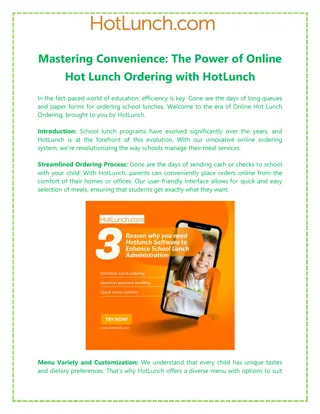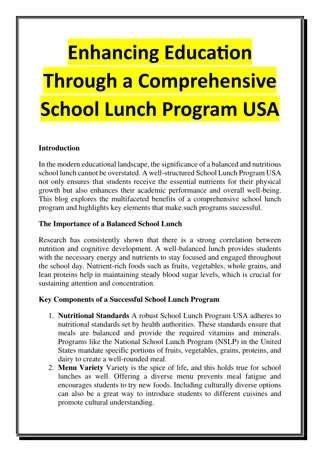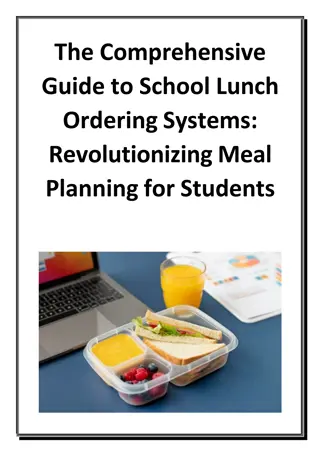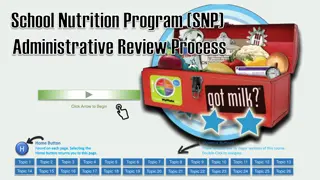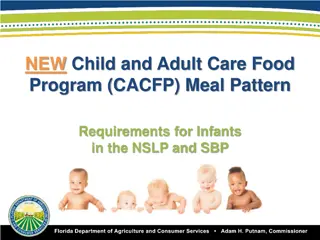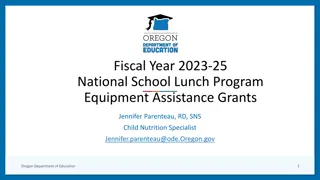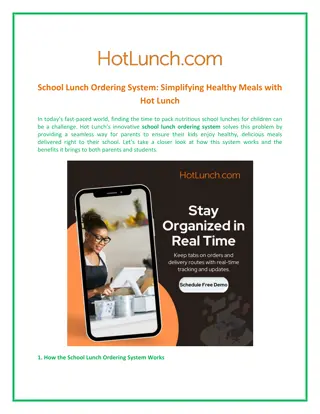Understanding the School Lunch Program in the USA
The School Lunch Program in the USA remains a vital initiative for ensuring the well-being of millions of children. While challenges exist, continuous efforts to improve meal quality, accessibility, and sustainability are paving the way for a healthi
Uploaded on Feb 23, 2025 | 1 Views
Download Presentation

Please find below an Image/Link to download the presentation.
The content on the website is provided AS IS for your information and personal use only. It may not be sold, licensed, or shared on other websites without obtaining consent from the author. Download presentation by click this link. If you encounter any issues during the download, it is possible that the publisher has removed the file from their server.
E N D
Presentation Transcript
Understanding Program Challenges, and Future Prospects the the School USA: Lunch Benefits, in Introduction The School Lunch Program in the USA plays a crucial role in providing nutritious meals to millions of children across the country. Established to combat childhood
hunger and promote healthy eating habits, this program ensures that students receive well-balanced meals that support their physical and cognitive development. This article explores the history, benefits, challenges, and future of the School Lunch Program in the United States. History of the School Lunch Program The National School Lunch Program (NSLP) was introduced in 1946 under the National School Lunch Act, signed by President Harry Truman. The program was developed in response to concerns about malnutrition among children, especially those from low-income families. Over the years, the program has evolved to accommodate changing nutritional standards and societal needs. In 2010, the Healthy, Hunger-Free Kids Act (HHFKA) was passed, introducing stricter nutritional guidelines, increasing access to healthy foods, and emphasizing fruits, vegetables, and whole grains in school meals. This act aimed to curb the rising rates of childhood obesity while ensuring that children had access to nutritious meals. Benefits of the School Lunch Program 1. Nutritional Support for Children One of the main advantages of the School Lunch Program is that it provides essential nutrients to students, ensuring they have the energy and focus needed for academic success. Meals are designed to meet dietary guidelines and often include proteins, grains, fruits, vegetables, and dairy products. 2. Combatting Childhood Hunger For many children, school meals are the only nutritious food they receive in a day. The NSLP helps reduce food insecurity, ensuring that students from economically disadvantaged backgrounds do not go hungry during school hours. 3. Encouraging Healthy Eating Habits The program promotes balanced meals and introduces students to healthier food choices. With a focus on fresh fruits, vegetables, whole grains, and lean proteins, school lunches help shape lifelong healthy eating habits.
4. Improving Academic Performance Nutrition plays a key role in cognitive function and concentration. Research indicates that students who receive nutritious school lunches perform better academically, have improved memory, and exhibit higher levels of engagement in the classroom. 5. Supporting Low-Income Families Families struggling financially benefit from subsidized or free school meals, reducing their financial burden and ensuring that children have access to quality nutrition without additional costs. 6. Promoting Social Equity The NSLP bridges the gap between students from different economic backgrounds, ensuring that every child, regardless of their financial situation, has access to a nutritious meal. Challenges of the School Lunch Program 1. Budget Constraints Despite the program s success, funding remains a significant challenge. Schools often struggle to provide high-quality meals within tight budgets, leading to concerns about food variety and portion sizes. 2. Food Waste A major concern is food waste in schools. Many students discard portions of their meals, leading to wastage of resources and funds. Efforts are being made to educate students on the importance of reducing food waste. 3. Nutritional Quality vs. Taste While school meals follow strict nutritional guidelines, some students find them unappetizing. Balancing nutritional value with taste preferences remains a challenge for school meal planners. 4. Access to Fresh Ingredients Not all schools have access to fresh fruits, vegetables, and locally sourced foods. Rural areas, in particular, may face logistical challenges in providing fresh, healthy meals to students.
5. COVID-19 Impact The COVID-19 pandemic disrupted school meal programs, highlighting the reliance of many children on these services. Many schools had to adapt quickly by offering take-home meal programs to ensure continued access to food. Future of the School Lunch Program 1. Incorporating More Local and Organic Foods There is a growing push to integrate locally sourced and organic foods into school meals, ensuring fresher and healthier options for students. 2. Technology in School Lunch Programs Technology is playing a role in improving meal planning, reducing food waste, and ensuring efficient distribution. Digital platforms help schools track nutrition and gather student feedback to improve meal options. 3. Expanding Free Meal Programs Many advocates are pushing for universal free school meals to eliminate the stigma associated with free or reduced lunch programs and ensure every child has access to proper nutrition. 4. Nutritional Education Educating students about the benefits of healthy eating and involving them in food selection can increase meal acceptance and reduce food waste. 5. Partnerships with Non-Profits and Businesses Collaborations with non-profit organizations and businesses can help schools improve meal quality, secure funding, and promote healthier food choices. Conclusion The School Lunch Program in the USA remains a vital initiative for ensuring the well-being of millions of children. While challenges exist, continuous efforts to improve meal quality, accessibility, and sustainability are paving the way for a healthier future. By addressing funding issues, enhancing nutritional education, and adopting innovative solutions, the program can continue to positively impact students' lives, ensuring that every child receives the nutrition they need to succeed.














